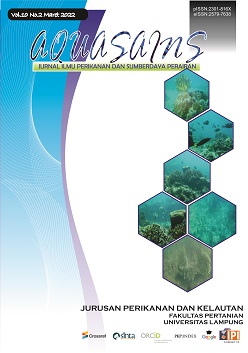GROWTH AND SURVIVAL OF TILAPIA (Oreochromis niloticus) WITH STARVED PERIODICALLY IN BEDENG MUNIR VILLAGE, SOUTH PAGAR ALAM
DOI:
https://doi.org/10.23960/aqs.v10i2.p1125-1130 Abstract View: 182
Abstract View: 182
Abstract
Abstract
This time fish farmers often face constraints on the high price of commercial feed which results in low profits for the farmers. One solution to reduce artificial feed is periodic starvation. Starvation can reduce and increase feed efficiency while increasing production and fish can grow equally without fasting. The purpose of this study was to determine the growth and survival of periodically fasted tilapia (Oreochromis niloticus) in Bedeng Munir Village, South Pagar Alam. The method used in fish farming consisted of two treatments, that is P0: control and P1: fasting treatment (fish were given commercial feed for 4 days and fasted for 1 day). The parameters observed were absolute length growth, absolute weight growth, total feed consumption, feed efficiency, survival, and water quality. The results showed that the P1 treatment produced the highest absolute weight growth of 16.5 g, the highest absolute length growth was 1.35 cm, the lowest amount of feed consumption was 1540 g, the highest feed efficiency was 204.94%, the survival rate was 89. %,. While water quality in both the treatment is still in the range of tolerance for tilapia as temperature 21.4 to 24.2 0C and pH 7.6 to 8.1.
Keywords
Growth, tilapia, starvation, survival.
Downloads
Downloads
Published
How to Cite
Issue
Section
License
License for Authors
Authors who publish with this journal agree to the following terms:
- Authors retain copyright and grant the journal right of first publication with the work simultaneously licensed under a Creative Commons Attribution License that allows others to share the work with an acknowledgement of the work's authorship and initial publication in this journal.
- Authors are able to enter into separate, additional contractual arrangements for the non-exclusive distribution of the journal's published version of the work (e.g., post it to an institutional repository or publish it in a book), with an acknowledgement of its initial publication in this journal.
- When the article is accepted for publication, its copyright is transferred to Aquasains Journal. The copyright transfer convers the exclusive right to reproduce and distribute the article, including offprint, translation, photographic reproduction, microfilm, electronic material, (offline or online) or any other reproduction of similar nature.
- Authors are permitted and encouraged to post their work online (e.g., in institutional repositories or on their website) prior to and during the submission process, as it can lead to productive exchanges, as well as earlier and greater citation of published work (See The Effect of Open Access).
- The Author warrant that this article is original and that the author has full power to publish. The author sign for and accepts responsibility for releasing this material on behalf os any and all-author. If the article based on or part os student’s thesis, the student needs to sign as his/her agreement that his/her works is going published.
License for Regular Users
Other regular users who want to cite, distribute, remix, tweak, and build upon author’s works, even for commercial purposes, should acknowledge the work’s authorship and initial publication in this journal, licensed under a Creative Commons Attribution License.
This license lets others distribute, remix, tweak, and build upon your work, even commercially, as long as they credit you for the original creation.
This work is licensed under a Creative Commons Attribution 4.0 International License.Copyright Transfer Statement can be downloaded here


.png)









